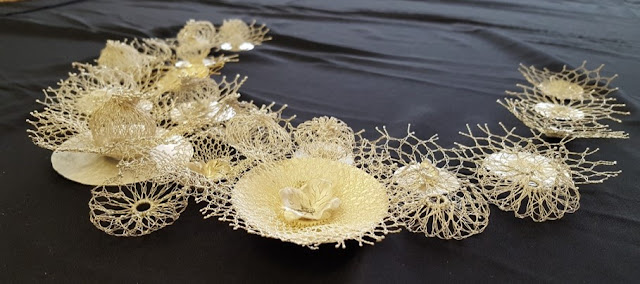The purpose of my research mainly focused on two objectives.
The first was to examine and investigate gendered identities of feminism and
its associations with metallic and lace inspired jewellery. The second
objective was to progressively integrate and manipulate the technique of bobbin
lace within jewellery. Both textile lace and jewellery are associated to gender
and identity stereotypes, usually imposed by a patriarchal society. My research
aimed at highlighting these elements and allowing one to understand jewellery
through an empowerment lens. Interlacing Identities is a product and
representation of the powerful role in which women played in their ability to
produce, wear and represent lace. This piece also demonstrates the complexities
and evolution of the functions of lace, and its continuously changing
constructs associated with it during the course of history. Critically
analysing lace jewellery allows for a deeper understanding with regards to
society and its interaction with these techniques, which are predominantly
programmed within a pre-existent context; shed light on the success of women
within these fields and pays attention to the impact enforced by a patriarchal
society.
Jewellery has been in existence for centuries however, contemporary
jewellery in South Africa is a growing field which allows for a deeper
understanding of jewellery through academia as well as within our society. Contemporary
jewellery can also be explained as the need to break away from the pre-existing
traditional connotations associated to jewellery, through unusual and innovative
design, the use of alternative materials and techniques. The importance of
associating, understanding and aligning jewellery through both social and
artistic constructs allows for epistemological gain which is critical for
research. The way in which we relate to jewellery design and manufacture
practices are no longer confined only to the wearability and aestheticism of
jewellery. My piece allows one to identify and consider the existence of
complex feminine identities within lace jewellery and broaden the perspective
on jewellery itself. The metaphorical analyses of the piece also provides
support for the complexities presented in a gendered society.
The
technique of bobbin lace within jewellery should be highlighted as it is this
innovation within contemporary jewellery, a niche and growing field, which allows
one to provide new knowledge and align itself to a new set of ideals. The
design and manufacture of this piece is where I played in the realm of binary
opposites, which allows for epistemological insight of feminine roles within a patriarchal
society of jewellery design and manufacture. Bobbin lace is a French lace
technique which I adapted and changed within a jewellery context. The integration
and investigation of techniques from other disciplines allowed me to push the
boundaries of design and aligns my piece to a new set of ideals within
jewellery design and manufacture, such as cross integration of techniques and
skills development.
In 2018, Interlacing
Identities participated in the Inaugural Contemporary Jewellery Awards
Exhibition in South Africa, whereby it was part of an exhibition hosted at the
University of Johannesburg, FADA Gallery in Johannesburg on the 15th
March 2018. It received an award as ‘Runner Up’ in the awards. As part of the
award prize, Interlacing Identities was featured in a magazine
called Creative Feel, April 2018 edition. In addition to this accolade, Interlacing
Identities also featured as part of an article written by Geraldine Fenn,
“Contemporary Jewelry in South Africa”, which was published in an international
magazine called Metalsmith Vol 39.
Group Exhibition – Contributors/ Participants
Joani Groenewald - joani@sun.ac.za
Lani van Niekerk - lanivn@gmail.com
Nina Newman - newmann@tut.ac.za
Gussie van de Merwe - gussievdmerwe@gmail.com
Erika Wessels - erika@erikawessels.com
Karien van der Schyff - kvldesigns@gmail.com
Eric Loubser - eric@ericloubser.com
Samantha Vincent - samanthav@dut.ac.za
Alisa Knoblauch - alisavdmerwe@gmail.com
Jan Bekker - jan@sirkeljewellery.co.za
Michelle Liao - michelleliaosa@gmail.com
Hilda Swart - hildaleswart@gmail.com
Marchand van Tonder - info@studioloubser.com
Liz Loubser - liz@lizloubser.com
Tracey Jane Lötter - tracey@madeofmettle.co.za
Mariét Schwalb - mapuladesigner@gmail.com
Nora Korvats - info@norakovats.com
Chris De Beer - chrisdb@dut.ac.za
Marlene DE Beer - marlenedb@dut.ac.za
Anne Manaczynski - anaczynski@gmail.com
Philisa Zibi - philisa.zibi@gmail.com
Adeline Joubert Heyns - info@firepetals.com
Images of Work: Interlacing Identities
 |
| Mariambibi Khan. 2015. Interlacing Identities. Bobbin Lace, Fine Silver, Sterling Silver & Gold Plating – Front, black background. |
 |
| Mariambibi Khan. 2015. Interlacing Identities. Bobbin Lace, Fine Silver, Sterling Silver & Gold Plating – Front full, black background. |
 |
| Mariambibi Khan. 2015. Interlacing Identities. Bobbin Lace, Fine Silver, Sterling Silver & Gold Plating – Detailed photographs, black background. |
 |
| Mariambibi Khan. 2015. Interlacing Identities. Bobbin Lace, Fine Silver, Sterling Silver & Gold Plating – Front & Detailed photographs, Grey background. Photography: Roland Woon. |
 |
| Mariambibi Khan. 2015. Interlacing Identities. Bobbin Lace, Fine Silver, Sterling Silver & Gold Plating – Front & Detailed photographs, Grey background. Photography: Roland Woon. |
 |
| Mariambibi Khan. 2015. Interlacing Identities. Bobbin Lace, Fine Silver, Sterling Silver & Gold Plating – Front & Detailed photographs, Grey background. Photography: Roland Woon. |
Metalsmith Magazine, Vol 39 – No 2 Edition – Cover Page & Contents - Screenshots
Metalsmith Magazine, Vol 39 – No2 Edition – Article - Screenshots











































